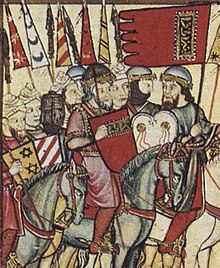Muhammad I. ibn Nasr

Muhammad I ibn Yūsuf ibn Nasr ( Arabic محمد بن يوسف بن نصر, DMG Muḥammad b. Yūsuf b. Naṣr ; * around 1194 in Arjona , province of Jaén ; † January 22, 1273 near Granada ), known as al-Ahmar (الأحمر / al-Aḥmar / 'the red one', because of his red beard), or al-Sheikh (الشيخ / aš-Šayḫ / 'the old man') or al-Ghālib bi-Llāh (الغالب بالله / al-Ġālib bi-Llāh / 'the Victorious for Allah') was emir of Granada from 1232 to 1273 .
history
With the defeat of the Almohads in the battle of Las Navas de Tolosa (1212), their control over Al-Andalus was considerably weakened. The rebellion of Ibn Hud of Murcia led to the final collapse of their rule . Although this subjugated almost all Muslim areas in Andalusia, but he was unable to defend the country against the attacks of Castile and León . In 1232 Muhammad ibn Nasr rose and was proclaimed emir in Arjona. His dominion extended over a relatively small region, which included Jaén , Guadix and Baeza . Of great importance for securing the Nasrid rule was the support of another family from Arjona, the Banū Ashqilūla; these also helped Muhammad in 1233 in his unsuccessful attempt to wrest Seville from Ibn Hūd's rule. Muhammad I secured the support of the Banū Ashqilūla with the promise to share power with them. In 1234 he had to submit to Ibn Hūd in order to be recognized by him in his home region.
Although Muhammad had submitted to Castilian sovereignty in 1236, he was able to conquer Granada in 1237, which he made the residence of his kingdom. A year later (1238) Almería fell into his hands, and a little later Malaga also sent envoys to invite him to take over power. In 1242 Muhammad submitted to the Hafsiden ruler Abu Zakariya Yahya I. In 1246, Muhammad Jaén had to give up and become a vassal to the Castilian ruler Ferdinand III. to step. The greatest proof of his loyalty to Castile was his military success in the conquest of Seville (1248). In return, he was the only Muslim ruler to maintain his rule on the Iberian Peninsula.
In the period that followed, the Nasrid Empire was consolidated . As a result of the settlement of Muslim refugees from the areas conquered by the Christians , the population increased considerably and achieved great homogeneity, so that the old antagonism between Arabs and Berbers lost its importance (see: Caliphate of Córdoba ). The Muslim immigration resulted in a considerable economic upswing. However, the empire remained dependent on the Christian sea powers Aragon and Genoa for foreign trade throughout its existence . Under Muhammad I, the expansion of the Alhambra into a fortress and residence began in Granada . In 1257, Muhammad I appointed his two sons Muhammad and Yūsuf as heirs to the throne. In doing so, however, he brought the Banū Aschqilūla against him because they now felt excluded from power.
Towards the end of his reign, Muhammad I came into conflict with Castile when the latter demanded the cession of Tarifa and Gibraltar . When Muhammad I refused and in 1265 promoted the Mudejar uprising in Castile, Alfonso X moved as far as Granada and forced an increase in the tribute. In addition, Castile allied itself with the oppositional Banū Aschqilūla. Muhammad I, conversely, supported the Castilian nobility against Alfonso X.
Muhammad I was ambushed not far from Granada during a campaign against some apostates and was killed (1273). When he died, he left a largely solid empire that could withstand Christian pressure for another 200 years. He was succeeded by his son Muhammad II. Al-Faqih (r. 1273-1302).
literature
- Thomas Freller: Granada. Kingdom between Orient and Occident. Jan Thorbecke Verlag, Ostfildern 2009, ISBN 978-3-7995-0825-4 .
- Ulrich Haarmann: History of the Arab World. CH Beck, Munich 2001, ISBN 3-406-38113-8 .
- LP Harvey: Islamic Spain, 1250-1500. University of Chicago Press, Chicago 1990, ISBN 0-226-31960-1 , pp. 20-40 ( limited preview in Google book search).
- Maḥmūd ʿAlī Makkī: The Nasrid Granada. In: Almut von Gladiß (ed.): Treasures of the Alhambra: Islamic art in Andalusia. [Exhibition in the special exhibition halls at the Kulturforum Berlin, October 29, 1995 to March 3, 1996.] Exhibition catalog. Skira, Milano 1995, ISBN 88-8118-034-0 , pp. 39-59.
Web links
- Emirat of Granada (English)
Individual evidence
- ↑ See Harvey: Islamic Spain, 1250 to 1500. 1990, p. 32 f.
- ↑ See Harvey: Islamic Spain, 1250 to 1500. 1990, p. 22 f.
- ↑ See Harvey: Islamic Spain, 1250 to 1500. 1990, p. 27.
- ↑ See Harvey: Islamic Spain, 1250–1500. 1990, p. 33.
- ↑ See Harvey: Islamic Spain, 1250 to 1500. 1990, p. 27.
- ↑ See Harvey: Islamic Spain, 1250 to 1500. 1990, pp. 25 f.
- ↑ See Harvey: Islamic Spain, 1250 to 1500. 1990, p. 26.
| predecessor | Office | successor |
|---|---|---|
| --- |
Emir of Granada 1232–1273 |
Muhammad II al-Faqih |
| personal data | |
|---|---|
| SURNAME | Muhammad I. ibn Nasr |
| ALTERNATIVE NAMES | Ibn al-Aḥmar; aš-ay; al-Galib billah; Muḥammad I ibn Yūsuf ibn Naṣr |
| BRIEF DESCRIPTION | Emir of Granada (1232–1273) |
| DATE OF BIRTH | around 1194 |
| PLACE OF BIRTH | Arjona |
| DATE OF DEATH | January 22, 1273 |
| Place of death | near Granada |
